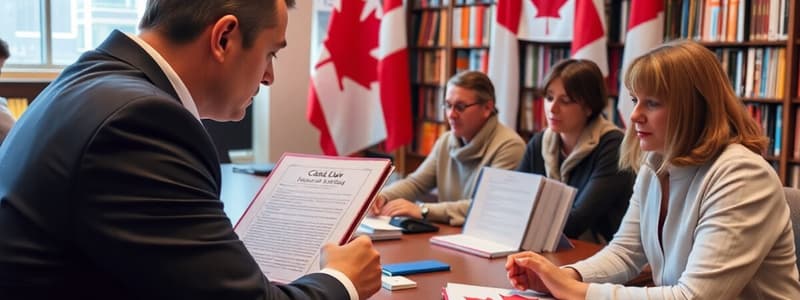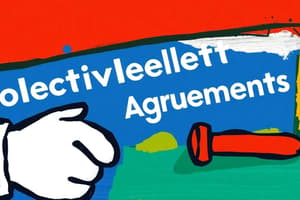Podcast
Questions and Answers
What is the primary purpose of a recognition strike?
What is the primary purpose of a recognition strike?
- To protest against unfair labor practices
- To assert the independence of workers from union influence
- To demand higher wages from the employer
- To pressure an employer to engage in collective bargaining with a union (correct)
In Canadian collective bargaining, what does the term 'bargaining structure' refer to?
In Canadian collective bargaining, what does the term 'bargaining structure' refer to?
- The identity and number of parties involved in collective bargaining (correct)
- The hierarchical levels of management involved in negotiations
- The legal rights of workers under Canadian labor law
- The geographical distribution of union members
Which stage of collective bargaining involves actual discussions and negotiation of terms?
Which stage of collective bargaining involves actual discussions and negotiation of terms?
- Negotiation stage (correct)
- Settlement stage
- Pre-negotiation stage
- Recognition stage
Who typically leads the collective bargaining negotiations for a union?
Who typically leads the collective bargaining negotiations for a union?
What initiates the collective bargaining process?
What initiates the collective bargaining process?
What is required for workers to decertify a union?
What is required for workers to decertify a union?
Which of the following describes unfair labour practices by employers?
Which of the following describes unfair labour practices by employers?
What is the primary purpose of the KVP test in assessing employer rules?
What is the primary purpose of the KVP test in assessing employer rules?
During the collective bargaining process, what is the first step?
During the collective bargaining process, what is the first step?
What could be a direct implication of union decertification for workers?
What could be a direct implication of union decertification for workers?
What defines the union's duty of fair representation?
What defines the union's duty of fair representation?
What is necessary for a legal strike in industrial conflict?
What is necessary for a legal strike in industrial conflict?
Which of the following is NOT a component involved in the grievance process?
Which of the following is NOT a component involved in the grievance process?
What is a characteristic of precarious work?
What is a characteristic of precarious work?
What does the Gini coefficient measure?
What does the Gini coefficient measure?
Which perspective emphasizes minimal union interference and promotes human resource management?
Which perspective emphasizes minimal union interference and promotes human resource management?
What type of strike occurs without union approval and is typically spontaneous?
What type of strike occurs without union approval and is typically spontaneous?
Which perspective views capitalism as inherently exploitative?
Which perspective views capitalism as inherently exploitative?
What is the primary focus of the Industrial Pluralist Perspective?
What is the primary focus of the Industrial Pluralist Perspective?
Which of the following is NOT a condition for a lawful strike?
Which of the following is NOT a condition for a lawful strike?
Sectoral bargaining involves which of the following?
Sectoral bargaining involves which of the following?
What type of grievance is filed on behalf of multiple employees?
What type of grievance is filed on behalf of multiple employees?
What is the purpose of Union Certification?
What is the purpose of Union Certification?
What is the term for the final and binding decision made by an arbitrator?
What is the term for the final and binding decision made by an arbitrator?
Which of the following is NOT a precondition for a legal strike?
Which of the following is NOT a precondition for a legal strike?
What does the term 'Decertification' refer to?
What does the term 'Decertification' refer to?
What does the term 'scabs' refer to in the context of strikes?
What does the term 'scabs' refer to in the context of strikes?
Which model establishes union exclusivity and collective bargaining rights?
Which model establishes union exclusivity and collective bargaining rights?
What is the role of a Craft Union?
What is the role of a Craft Union?
Which clause may require workers to join the union or pay dues?
Which clause may require workers to join the union or pay dues?
What does 'Majoritarianism' imply in union contexts?
What does 'Majoritarianism' imply in union contexts?
In public sector labour relations, what often acts as an alternative to strikes?
In public sector labour relations, what often acts as an alternative to strikes?
What is the practice of evaluating the reasonableness of employer rules called?
What is the practice of evaluating the reasonableness of employer rules called?
What is the primary function of a Replacement Worker during a strike?
What is the primary function of a Replacement Worker during a strike?
What is a cooling-off period in the context of strikes?
What is a cooling-off period in the context of strikes?
What does the term 'Scab' refer to in union contexts?
What does the term 'Scab' refer to in union contexts?
Which statement best describes the International Labour Organization (ILO)?
Which statement best describes the International Labour Organization (ILO)?
What is the primary role of bargaining concessions in collective bargaining?
What is the primary role of bargaining concessions in collective bargaining?
What defines the 'bottom line position' in bargaining negotiations?
What defines the 'bottom line position' in bargaining negotiations?
Which legislation primarily governs the actions of employers during the certification freeze?
Which legislation primarily governs the actions of employers during the certification freeze?
What is a characteristic of interest arbitration in the context of collective bargaining?
What is a characteristic of interest arbitration in the context of collective bargaining?
What is the role of statutory freeze provisions during a collective bargaining process?
What is the role of statutory freeze provisions during a collective bargaining process?
What factor can significantly impede the settlement process in collective bargaining?
What factor can significantly impede the settlement process in collective bargaining?
Which of the following is not typically considered a non-monetary issue in collective bargaining?
Which of the following is not typically considered a non-monetary issue in collective bargaining?
Which stage involves writing up the agreed terms of a collective agreement?
Which stage involves writing up the agreed terms of a collective agreement?
What is the primary goal of the duty to bargain in good faith?
What is the primary goal of the duty to bargain in good faith?
Which term describes the collective agreement vote by unionized employees?
Which term describes the collective agreement vote by unionized employees?
Flashcards
Bargaining Obligation
Bargaining Obligation
A legal obligation for employers and unions to negotiate with each other, even if one party prefers to avoid it.
Recognition Strike
Recognition Strike
A strike aimed at pressuring an employer to recognize and negotiate with a union.
Bargaining Structure
Bargaining Structure
The structure of a collective bargaining process, focusing on the parties involved and the scope of employees covered.
Notice to Bargain
Notice to Bargain
Signup and view all the flashcards
Chief Negotiator
Chief Negotiator
Signup and view all the flashcards
Union Certification
Union Certification
Signup and view all the flashcards
Unfair Labour Practices
Unfair Labour Practices
Signup and view all the flashcards
Union Duty of Fair Representation
Union Duty of Fair Representation
Signup and view all the flashcards
Union Decertification
Union Decertification
Signup and view all the flashcards
Collective Bargaining Process
Collective Bargaining Process
Signup and view all the flashcards
Management Rights
Management Rights
Signup and view all the flashcards
KVP Test
KVP Test
Signup and view all the flashcards
Grievance
Grievance
Signup and view all the flashcards
Precarious Work
Precarious Work
Signup and view all the flashcards
Sectoral Bargaining
Sectoral Bargaining
Signup and view all the flashcards
Gig Economy
Gig Economy
Signup and view all the flashcards
Neoclassical Perspective
Neoclassical Perspective
Signup and view all the flashcards
Managerialist Perspective
Managerialist Perspective
Signup and view all the flashcards
Industrial Pluralist Perspective
Industrial Pluralist Perspective
Signup and view all the flashcards
Critical Reformist Perspective
Critical Reformist Perspective
Signup and view all the flashcards
Gini Coefficient
Gini Coefficient
Signup and view all the flashcards
International Labour Organization (ILO)
International Labour Organization (ILO)
Signup and view all the flashcards
Decertification
Decertification
Signup and view all the flashcards
Exclusivity (in unionism)
Exclusivity (in unionism)
Signup and view all the flashcards
Industrial Union
Industrial Union
Signup and view all the flashcards
Majoritarianism
Majoritarianism
Signup and view all the flashcards
Craft Union
Craft Union
Signup and view all the flashcards
Minority Union
Minority Union
Signup and view all the flashcards
Replacement Workers
Replacement Workers
Signup and view all the flashcards
Monetary Issues
Monetary Issues
Signup and view all the flashcards
Non-Monetary Issues
Non-Monetary Issues
Signup and view all the flashcards
Ratification
Ratification
Signup and view all the flashcards
Bargaining Concessions
Bargaining Concessions
Signup and view all the flashcards
Bottom Line Position
Bottom Line Position
Signup and view all the flashcards
Interest Arbitration
Interest Arbitration
Signup and view all the flashcards
Statutory Freeze Provisions
Statutory Freeze Provisions
Signup and view all the flashcards
Certification Freeze
Certification Freeze
Signup and view all the flashcards
Collective Bargaining Freeze
Collective Bargaining Freeze
Signup and view all the flashcards
Duty to Bargain
Duty to Bargain
Signup and view all the flashcards
Just Cause
Just Cause
Signup and view all the flashcards
Strike
Strike
Signup and view all the flashcards
Labour Arbitration
Labour Arbitration
Signup and view all the flashcards
Back-to-Work Legislation
Back-to-Work Legislation
Signup and view all the flashcards
Card Check
Card Check
Signup and view all the flashcards
Study Notes
Canadian Labour Law
- The Canadian model for collective bargaining is based on the US Wagner Act (1935)
- It protects workers' rights to unionize
- Mandatory good-faith bargaining is introduced
- Mechanisms for resolving disputes (e.g. arbitration) are established
- Majoritarianism is key; a union is the exclusive representative if it secures majority support
Legal Institutions
- Labour Relations Boards (LRBs) oversee certification, unfair labour practices, and dispute resolution.
- Courts handle judicial reviews of LRB decisions and broader legal challenges.
- Arbitration Boards resolve disputes arising under collective agreements.
Common Core
- Right to Join a Union: Ensures freedom of association; prohibits employer interference.
- Good-Faith Bargaining: Mandates meaningful negotiations for collective agreements.
- No Strikes/Lockouts During Agreement: Promotes labour peace during contract terms.
- Prohibition of Unfair Labour Practices: Penalizes employer retaliation or union coercion.
- Conciliation: Requires mediation or conciliation before legal strikes or lockouts.
Alternatives to the Wagner Model
- Minority Unionism: Allows multiple unions to represent workers in a single workplace.
- Broader-Based Bargaining: Industry-wide or sectoral bargaining covering multiple employers; less common in Canada.
Historical Context
- Adoption began during WWII to manage industrial disputes.
- Post-war reforms solidified the Wagner model in Canadian labour law.
- Key Milestones: Wartime Labour Relations Regulations (PC 1003, 1944) formed the foundation for collective bargaining rights.
Legal Regimes
- Common Law: Historically limited collective rights; employer-favoured.
- Regulatory Regime: Introduces minimum employment standards and labour rights.
- Collective Bargaining Regime: Provides a framework for union recognition, good faith bargaining, and dispute resolution.
Union Certification
- Two pathways: Card check (automatic recognition) or mandatory vote.
- Labour boards verify union support.
Unfair Labour Practices
- Examples include employer threats, union coercion, or discriminatory actions.
- Remedies include reinstatement of fired workers and monetary penalties.
Union Duty of Fair Representation
- Unions must represent all members fairly without discrimination.
- Applies during grievances and collective agreement negotiations.
- Breaches can lead to legal action.
Union Decertification
- Process involves workers applying to decertify a union via LRBs and demonstrating majority support.
- Implications include loss of collective agreement protections and reversion to minimum employment standards.
Collective Bargaining Process
- Notice to bargain: Employer / Union sends a formal notice
- Proposal exchange
- Mediation or conciliation (if needed): Neutral third party facilitates discussions.
- Key Terms in Agreements: Wages, benefits, job security, grievance procedures, and management rights clauses.
Management Rights and KVP Test
- Management Rights: Residual rights unless limited by the agreement.
- KVP Test: Used to assess employer rules for consistency with the collective agreement, reasonableness, and enforceability.
Grievances, Labour Arbitration, and Just Cause
- Types of Grievances: Individual, group, or policy grievances.
- Labour Arbitration Process: Filing, pre-hearing, arbitration hearing, decision.
- Just Cause: Grounds for disciplinary action; assessed using the William Scott Test.
Industrial Conflict
- Strikes and Lockouts: Pre-conditions include legal strike votes and conciliation efforts; Public sector workers often face restrictions (essential services), especially strikes.
- Interest Arbitration: Alternative to strikes, especially in public sectors.
Studying That Suits You
Use AI to generate personalized quizzes and flashcards to suit your learning preferences.




